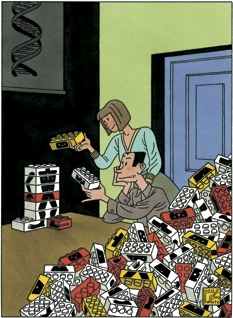
Once upon a time the young John Baldessari was so desperate for images that he prowled back alleys hunting for discarded photographs. He’d climb into garbage bins (diving head first was never the recommended technique) and rummage around, finding curious rejected pictures of odd male bowlers (something about what their hands revealed in the follow-through) or stiff ceremonial group portraits of beaming Caucasians with faces revealing their true jack-o-lantern selves, or a stack of dead bodies, or – simply and remarkably – a photograph of a standing man in a black suit which would eventually be cropped and tilted on its side and positioned at the bottom of a horizontal stack of other men – soldiers, cowboys, etc. – all of whom appear to have been shot dead in the street. The solitary living man in the black suit is on the bottom tier, facing up.
more from Benjamin Weissman at Frieze here.
S. Abbas Raza in Dawn:

The present danger to Pakistan comes from the lawlessness and terrorism in the country and the government’s inability to effectively project authority and guarantee the safety of its citizens. Islamic jihadist organisations with foreign funding appear to have joined hands with the Taliban and their sympathisers to wreak havoc in the country with their ultimate retrograde dream of creating a mediaeval society where a draconian interpretation of the Sharia is enforced, women kept as chattel and modernity and progress defeated.
Some of these groups are determined to attack and intimidate, if not eliminate, religious minorities. Then, we have the heavily armed militias affiliated with political parties. Finally, there are the criminal gangs involved in drug trafficking, kidnapping, carjacking, extortion, armed robbery and murder.
The idea that the army can somehow defend the country against this lawlessness is ludicrous. How can the armoured corps help fight sectarian car-bombings in Karachi? How will yet another squadron of F-16 aircraft defeat the drug smugglers in Lahore? How does the infantry do the detective work necessary to bring kidnappers and carjackers to justice? How can the army deal with the creators of mayhem that are thoroughly dispersed within our population, in every town and every city? It cannot. Yet the armed forces consume a hugely disproportionate share of Pakistan’s federal budget.
More here.
Black Bears
Up from the creek
where a shut-in
neighbor diligently
keeps vigil
and says
a mink and otter
can still be seen
and native brook trout
cross breed with the stocked
come black bears
first one and then a second
pass by my window
silent as ghosts
not a leaf disturbed
not even rousing the dogs
head swaying
moving with secret purpose
between houses
through the yards.
Who knows what else appears
while others are off to work
or the gym
and gardens are left
to browsing deer
also emerging lightly
with the resurrected
from the soft Indian
summer fog
settled along
the creek
wisps drifting
to my window
with the ghost bears
carrying
droplets glistening
on black fur.
By Harry Walsh
September 2009
Lydia Polgreen and Souad Mekhennet in the New York Times:

India and Pakistan have fought three wars since they were created by the bloody partition of British India in 1947. Whether they begin again the long journey toward peace or find themselves eyeball to eyeball, nuclear arms at the ready, depends in no small measure on the actions of this shadowy group.
A new attack could reverberate widely through the region and revive nagging questions about Pakistan’s commitment to stamp out the militant groups that use its territory.
It could also dangerously complicate the Obama administration’s efforts in Afghanistan. Success there depends in part on avoiding open conflict between India and Pakistan, so that Pakistan’s military can focus on battling the Taliban insurgents who base themselves in Pakistan.
Even so, American diplomatic efforts to improve India-Pakistan relations have been stillborn. So delicate is the Kashmir issue that Indian officials bridle at any hint of American mediation.
More here.
From The Telegraph:

In the 1950s, a Royal Commission identified as the single most important factor in marital breakdown the idealisation of the individual pursuit of sexual gratification and personal pleasure at the expense of a sense of reciprocal obligations and duties towards spouses, children and society as a whole. Not only did our ancestors know that they had to work at their marriage because there was no easy escape, but they saw the family as a microcosm of society, whose good order would contribute to the whole. Adulterers were severely and publicly punished – theoretically by death during the Commonwealth in the 1650s – because they had brought down God's wrath on the whole of society.
Adultery, nevertheless, was rife in a society where arranged marriages between couples who had barely met were the norm among the propertied class and divorce was impossible, except for the tiny elite who could afford a parliamentary divorce. Today, adultery often leads to divorce and remarriage, but in the past there was no such option. Marriage was for life, but then how long was life? Most marriages were cut short by death with the average marriage lasting eleven years, roughly the same figure as today when it is more likely to be terminated by divorce than death.
More here.
From Science:

As social as humans are, their cooperative nature pales in comparison to that of ants, bees, wasps, and termites (see hill, left). Colonies of these insects can number in the millions and function seamlessly as “superorganisms.” In their book, The Superorganism: The Beauty, Elegance, and Strangeness of Insect Societies, Burt Hölldobler and E. O. Wilson point out that this way of life makes for very successful living. These insects represent a mere 2% of the insect species yet take up two-thirds of the insect biomass. In tropical rainforests, ants outweigh all the mammals and land vertebrates combined.
More here.
Arthur Krystal in the New York Times:

That’s Vladimir Nabokov on my computer screen, looking both dapper and disheveled. He’s wearing a suit and a multibuttoned vest that scrunches the top of his tie, making it poke out of his shirt like an old-fashioned cravat. Large, lumpish, delicate and black-spectacled, he’s perched on a couch alongside the sleeker, sad-faced Lionel Trilling. Both men are fielding questions from a suave interlocutor with a B-movie mustache. The interview was taped sometime in the late 1950s in what appears to be a faculty club or perhaps a television studio decked out to resemble one. The men are discussing “Lolita.” “I do not . . . I don’t wish to touch hearts,” Nabokov says in his unidentifiable accent. “I don’t even want to affect minds very much. What I really want to produce is that little sob in the spine of the artist-reader.”
Not bad, I think, as I sit staring at the dark granular box on my YouTube screen. In fact, a damned good line to come up with off the cuff. But wait! What’s that Nabokov’s doing with his hands? He’s turning over index cards. He’s glancing at notes. He’s reading. Fluent in three languages, he relies on prefabricated responses to talk about his work.
More here.
Sebastian Horseley in Open:

I remember the first time I had sex—I still have the receipt. The girl was alive, as far as I could tell, she was warm and she was better than nothing. She cost me £20.
I was 16 then and I’m 47 now. I have spent 25 years throwing my money and heart at tarts. I have slept with every nationality in every position in every country. From high-class call girls at £1,000 a pop to the meat-rack girls of Soho at £15, I have probably slept with more than 1,300 prostitutes, at a cost of £115,000.
I am a connoisseur of prostitution: I can take its bouquet, taste it, roll it around my mouth, give you the vintage. I have used brothels, saunas, private homes from the Internet and ordered girls to my flat prompt as pizza. While we are on the subject, I have also run a brothel. And I have been a male escort. I wish I was more ashamed. But I’m not. I love prostitutes and everything about them. And I care about them so much I don’t want them to be made legal.
More here.
Tuesday, September 29, 2009

There’s something special about naming a celestial body, putting your thumbprint in the heavens up there with Jupiter and Mars and the Horsehead Nebula. The idea speaks to our desire for immortality–attaching a name to something that, if not quite eternal, will last far longer than anyone will be around to remember. The world of commerce has figured this out, of course. Various services have arisen that claim to put your name on a star for a fee. Unfortunately, as nice as it sounds, these names don’t count: You pay your money and get a certificate, but it isn’t recognized by the only organization that actually matters, the International Astronomical Union. So what if you really do want to name a piece of the sky? Is there a way to name a newly discovered star, or planet, or comet–maybe not after yourself, but maybe after someone you admire?
more from Samuel Arbesman at The Boston Globe here.

Katja Nicodemus interviews Lars von Trier, originally in Die Zeit, over at Signandsight:
You seem to be fascinated by power relationships. With the Dogma rules, you formulated an aesthetic manifesto and your last two films “Dogville” and “Manderlay” are based on strict formal principles. What so interests you about guidelines and rules?
I come from a family of communist nudists. I was allowed to do or not do what I liked. My parents were not interested in whether I went to school or got drunk on white wine. After a childhood like that, you search for restrictions in your own life.
But communists actually have very strict rules.
That’s true, but that’s where things start to get very complicated. All my life I’ve been interested in the discrepancy between philosophy and reality, between conviction and its implementation. The general assumption is that all people are able to differentiate more or less equally between good and evil. But if this is the case, why does the world look like it does? Why have all the good intentions of my parents come to nothing. And why do my own good intentions lead to nothing?

Paul Krugman reviews Robert Skidelsky’s Keynes: The Return of the Master in the Guardian:
In Part I of his 1936 masterwork, The General Theory of Employment, Interest, and Money, Keynes asserted that the core of his theory was the rejection of Say’s Law, the doctrine that said that income is automatically spent. If it were true, Say’s Law would imply that all the things we usually talk about when trying to assess the economy’s direction, like the state of consumer or investor confidence, are irrelevant; one way or another, people will spend all the income coming in. Keynes showed, however, that Say’s Law isn’t true, because in a monetary economy people can try to accumulate cash rather than real goods. And when everyone is trying to accumulate cash at the same time, which is what happened worldwide after the collapse of Lehman Brothers, the result is an end to demand, which produces a severe recession.
Some of those who consider themselves Keynesians, myself included, agree with what Keynes said in The General Theory, and consider the rejection of Say’s Law the core issue. On this view, Keynesian economics is primarily a theory designed to explain how market economies can remain persistently depressed.
But there’s an alternative interpretation of what Keynes was all about, one offered by Keynes himself in an article published in 1937, a year after The General Theory. Here, Keynes suggested that the core of his insight lay in the acknowledgement that there is uncertainty in the world – uncertainty that cannot be reduced to statistical probabilities, what the former US defence secretary Donald Rumsfeld called “unknown unknowns”. This irreducible uncertainty, he argued, lies behind panics and bouts of exuberance and primarily accounts for the instability of market economies.

Michael Specter in The New Yorker:
“What if we could liberate ourselves from the tyranny of evolution by being able to design our own offspring?” Drew Endy asked, the first time we met in his office at M.I.T., where, until the summer of 2008, he was assistant professor of biological engineering. (That September, he moved to Stanford.) Endy is among the most compelling evangelists of synthetic biology. He is also perhaps its most disturbing, because, although he displays a childlike eagerness to start engineering new creatures, he insists on discussing both the prospects and the dangers of his emerging discipline in nearly any forum he can find. “I am talking about building the stuff that runs most of the living world,” he said. “If this is not a national strategic priority, what possibly could be?”
Endy, who was trained as a civil engineer, spent his youth fabricating worlds out of Lincoln Logs and Legos. Now he would like to build living organisms. Perhaps it was the three well-worn congas sitting in the corner of Endy’s office, or the choppy haircut that looked like something he might have got in a tree house, or the bicycle dangling from his wall—but, when he speaks about putting together new forms of life, it’s hard not to think of that boy and his Legos.
Endy made his first mark on the world of biology by nearly failing the course in high school. “I got a D,” he said. “And I was lucky to get it.” While pursuing an engineering degree at Lehigh University, Endy took a course in molecular genetics. He spent his years in graduate school modelling bacterial viruses, but they are complex, and Endy craved simplicity. That’s when he began to think about putting cellular components together.
Arundhati Roy in The Nation:

The question here, really, is what have we done to democracy? What have we turned it into? What happens once democracy has been used up? When it has been hollowed out and emptied of meaning? What happens when each of its institutions has metastasized into something dangerous? What happens now that democracy and the free market have fused into a single predatory organism with a thin, constricted imagination that revolves almost entirely around the idea of maximizing profit?
Is it possible to reverse this process? Can something that has mutated go back to being what it used to be? What we need today, for the sake of the survival of this planet, is long-term vision. Can governments whose very survival depends on immediate, extractive, short-term gain provide this? Could it be that democracy, the sacred answer to our short-term hopes and prayers, the protector of our individual freedoms and nurturer of our avaricious dreams, will turn out to be the endgame for the human race? Could it be that democracy is such a hit with modern humans precisely because it mirrors our greatest folly–our nearsightedness?
More here.
Bill Wyman in Salon:

Bad art is supposed to be harmless, but the 2008 film “Roman Polanski: Wanted and Desired,” about the notorious child-sex case against the fugitive director, has become an absolute menace. For months, lawyers for the filmmaker have been maneuvering to get the Los Angeles courts to dismiss Polanski's 1978 conviction, based on supposed judicial misconduct uncovered in the documentary. On Tuesday, Los Angeles Superior Court Judge Peter Espinoza ruled that if Polanski, who fled on the eve of his sentencing, in March 1978, wanted to challenge his conviction, he could — by coming back and turning himself in.
Espinoza was stating the obvious: Fugitives don't get to dictate the terms of their case. Polanski, who had pleaded guilty to having unlawful sex with a 13-year-old girl, was welcome to return to America, surrender, and then petition the court as he wished. Indeed, the judge even gave Polanski more than he deserved, saying that he might actually have a case. “There was substantial, it seems to me, misconduct during the pendency of this case,” he said, according to the Los Angeles Times. “Other than that, he just needs to submit to the jurisdiction of the court.”
Polanski deserves to have any potential legal folderol investigated, of course. But the fact that Espinoza had to state the obvious is testimony to the ways in which the documentary, and much of the media coverage the director has received in recent months, are bizarrely skewed. The film, which has inexplicably gotten all sorts of praise, whitewashes what Polanski did in blatant and subtle fashion — and recent coverage of the case, in the Los Angeles Times, the New York Times and elsewhere, has in turn accepted the film's contentions at face value.
More here. [Thanks to Cyrus Hall.]
Also see: Reminder: Roman Polanski raped a child –excellent article by Kate Harding
And: Child Rape Apologists Love Roman Polanski –by Gautham Nagesh
From Edge:

In June, 1948, I graduated from Yale and prepared to enter graduate school in physics in the fall. The results of my applications were very disappointing. Harvard admitted me but offered no financial aid. Princeton turned me down flat. At Yale, I was admitted to graduate school in mathematics, but not in physics. The one encouraging reply from a physics department came from MIT. I was admitted and offered the job of assistant to a theoretical physics professor named Victor Weisskopf, of whom I had never heard. When I inquired about him, I was told he was a wonderful man and an excellent physicist and that everyone called him by his nickname, Viki. He wrote me a very nice letter saying he hoped I would come to MIT and work with him.
I was still discouraged, though, about having to go to MIT, which seemed so grubby compared with the Ivy League. I thought of killing myself (at the age of 18) but soon decided that I could always try MIT and then kill myself later if it was that bad but that I couldn't commit suicide and then try MIT afterwards. The two operations, suicide and going to MIT, didn't commute, as we say in math and physics jargon.
More here.
Nicholas Wade in The New York Times:

Who would have thought it? The quest for eternal life, or at least prolonged youthfulness, has now migrated from the outer fringes of alternative medicine to the halls of Harvard Medical School. At a conference on aging held here last week, the medical school’s dean, Jeffrey Flier, was to be seen greeting participants who ranged from members of the 120 club (they intend to live at least that long) to devotees of very low calorie diets. The heavyweight at the conference was Sirtris Pharmaceuticals. The company is developing drugs that mimic resveratrol, a chemical found in some red wines. Resveratrol has been found to activate proteins called sirtuins, from which the company derives its name. Activation of sirtuins is thought to help the body ride out famines.
Mice and rats put on a diet with 30 percent fewer calories can live up to 40 percent longer. They seem to do so by avoiding the usual degenerative diseases of aging and so gain not just longer life but more time in good health. Sirtris’s researchers think that drugs that activate sirtuins mimic this process, strengthening the body’s resistance to the diseases of aging. The company has developed thousands of small chemical compounds that are far more potent than resveratrol and so can be given in smaller doses.
More here.
Ben Zimmer at the Visual Thesaurus:

William Safire passed away over the weekend at the age of 79, and his loss is felt particularly strongly by those who loyally followed his “On Language” column in the New York Times Magazine for the past three decades. Safire retired from his Pulitzer Prize-winning political column for the Times in 2005, but he continued to relish his role as “language maven” to the very end. He was not simply a pundit on matters political and linguistic, however: he was also an extremely generous man, both publicly in his philanthropic work with the Dana Foundation and privately with friends and colleagues.
On hearing of his passing, fellow maven Paul Dickson remarked to me that Safire “opened a door which a lot of people got to walk through and play with words as a vocation.” That was certainly true in my case. As a word nerd in training, I read “On Language” religiously every Sunday. When I was perhaps nine or ten, I recall taking issue with something Safire had said in one of his columns and writing a letter to him (in pencil!). Unfortunately, I was too intimidated to follow through and never mailed the letter.
Flash-forward to 2003, when I was bit braver in corresponding with him. He often published requests for assistance from those he dubbed “Lexicographic Irregulars” (word sleuths after the manner of Sherlock Holmes' Baker Street Irregulars). On this occasion he sent out a request about the history of the expression “stay the course.”
More here.
Monday, September 28, 2009

An-My Le. Night Operations #7. 2003-2004
Gelatin silver print.
More here, here and here.
